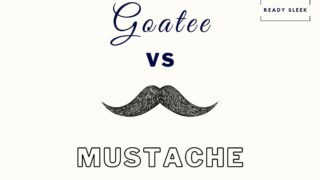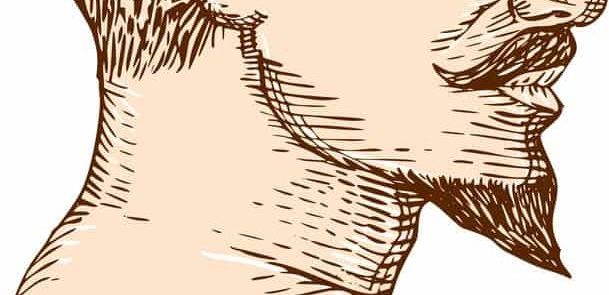There’s a reason bearded men are so passionate. Growing a beard takes dedication and patience. But as a beard grows, so do its problems. So, how do you fix an asymmetrical-looking beard?
Asymmetrical beards can be helped using a number of different methods. These include adjusting the style, regular brushing, or even just growing it out a little longer.
The strategy you choose depends on the particular reason your beard looks asymmetrical in the first place.
No two beards are the same.
Your bearded problems may be entirely different to those of the bearded man standing next to you.
The first step is figuring out what makes your beard look asymmetrical.
The second step is to do something about it.
Let’s get to it.
N.B – This is a general style/grooming article, not professional advice. If you have any concerns about an uneven or unusual distribution of growth, seek professional advice.
Common Reasons Beards Look Asymmetrical
This is by no means all there is to it. But there’s a good chance that your problems are caused by one of these problems.
If they aren’t, don’t worry about it. There’s a very good chance at least one of the tips I list later on will work for you anyway.
1. One Cheek Is Patchier Than The Other
“Patchier”. “Thinner”. Whatever you want to call it, many men do find that their cheeks are the culprit.
It’s pretty common.
It’s frustrating, it’s confusing, but boy is it common.
2. The Grain Is Different On One Side
Beard hair grows in many different directions.
It doesn’t play by any of the rules you might have in mind.
You’d like to think a beard flows straight, flat, and downward right from the start.
Before you know it, you’ve got a glorious Viking-esque beard that turns heads and breaks hearts like nobody’s business.
Unfortunately, that really is a fairy tale. It doesn’t happen.
The “grain” is the general direction of hair growth. Overall, you’d like this direction to be exactly the same on both sides.
This is what would produce that beautiful symmetry.
But in reality, the general direction of beard hair on one side may be different from that on the other.
In addition, the variation in direction may just be a lot more obvious on one side than the other.
7 Style Tips For Asymmetrical Beards
This list is in no particular order. When discussing each tip, I’ll mention which particular symmetry problems it would be best at fixing.
You’ll probably realize that a lot of these tips are just good grooming habits to get into regardless of whether you’ve got an uneven beard or not.
So, there’s a good argument for practicing all of them.
1. Grow It Longer
OK. So this one may not be for everyone. If this isn’t an option for you, skip straight to the next tip.
But here’s what it comes down to.
Some beard problems will, for the most part, sort themselves out as the hair grows longer.
Simply growing the hair longer might help patchy cheeks look more evenly distributed and symmetrical.
Ultimately, you could say this was the “easiest” tip. But in many ways, it isn’t. Longer beards do have additional and more intense maintenance requirements.
It also isn’t a sure thing – you may find that your specific symmetry problems aren’t completely solved by this.
But it’s probably worth a shot.
2. Consider Brushing
This only refers to boar bristle beard brushes. Synthetic nylon beard brushes generally do more harm than good.
Boar bristles are very similar to beard hair in texture, so are able to glide through it without causing much tugging or pulling.
Once you’ve got three or four weeks of growth, your beard is probably long enough to benefit from it.
Over time, you may find that the general direction of the hair is more uniform.
This includes hair on the chin, under the chin, the cheeks, and the mustache.
After you’ve been practicing daily beard brushing for a while, you’ll probably notice that you need to brush less to produce the same effect.

It also prevents natural oils from clogging up the bases of the hair and distributes it across the beard evenly.
3. Style It Out
You may have dreamt of a specific beard style all your life. But at the end of the day, it may not actually suit your specific distribution of hair.
It’s important to be smart about it.
If you find that your beard is asymmetrical, there’s a chance you may be able to fix this by simply styling it out.
In other words, choose a style that reduces the appearance of asymmetry.
Here’s an example.
Let’s say the main cause of asymmetry is the patchiness of your cheek hair. One cheek just looks thinner and patchier than the other.
Here are a couple of quick solutions:
- Trim a goatee. Goatees are great because they completely remove the need for cheek hair altogether. They’re defined by there being hair on the chin but not on the cheeks. Just shave that patchy cheek hair off of each side completely.
- Trim a Short Boxed Beard. These beards are defined by lowered cheek lines. The borders sit very low down the cheeks. It’s a great option if you don’t want to commit to a goatee.
The bottom line is this.
If you notice that one part of your beard is the main source of asymmetry, there’s a pretty good chance that one of the dozens of beard styles out there could remove it.
4. Consider Beard Balm
Beard balm isn’t quite as essential as a boar bristle beard brush is. However, it would still be a very worthy component of your grooming toolkit.
Here’s why.
It tames strays.
Stray hairs stick out and point in all sorts of directions. As you’re growing out a beard, you’ll find that not all of the hair grows at the same rate.
Some grows quicker and some grows slower. This leads to hairs of different lengths lying very close to each other.
Essentially, this difference in length does lead to an uneven, untidy appearance.
Beard balm helps because it flattens out the strays, making the entire beard look more uniform, neat, and symmetrical.
It’s great because it’s quite gentle. It isn’t as heavy or overbearing as products such a beard wax can be.
Beard balm may not have as strong of a hold as beard wax, but it’s light, comfortable, and often does the job you need it to.
5. Consider Beard Oil
Although using beard oil in itself won’t directly tackle the problem of asymmetry, it does enhance the effects of the other tips in this list.
Let me explain.
Applying a small amount of beard oil before brushing your beard will allow the bristles to glide through the hair easier.
It’ll generally make it easier to style. Beard hair is usually more likely to stay in place and beard balm will find it easier to do its job of taming strays.
6. Get Comfortable Using Beard Scissors
Using scissors to trim a beard may seem inefficient at first. Surely a pair of clippers or a decent trimmer could get the job done quicker.
Unfortunately, using electric devices such as these is a common cause of asymmetry, funnily enough.
The reason for this is that they don’t allow you to sculpt the beard in any sort of intricate way.
They’re great for taking large chunks off of your beard when you need to.
But if you’re looking to make small trims here or there you’ll probably find that you took more off than you initially intended to.
Asymmetry in your beard is often caused by small, intricate details.
In other words, some stray and rogue hairs in specific places on your beard.
If you try to remove these hairs using a trimmer, you’ll probably trim off some surrounding hairs unintentionally as well.
You could call them innocent bystanders.
Using a pair of beard scissors gives you a lot more control. You’re able to make small cuts in awkward places, tackling asymmetry one rogue hair at a time if you need to.
Sure, it can take time. But that’s often what it takes.
7. Maintain The Borders
Specifically, maintain the cheek lines and the neckline.
The cheek lines are the “upper borders” of the beard. They’re where your cheek hair meets your cheek skin.
The neckline is the “lower border” – where the neck hair meets your neck skin.
Earlier I mentioned that asymmetry under the chin was a common problem.
The direction of hair growth may lean toward one side more than the other, making one side look thicker than the other.
A possible (but most likely not complete) tip would be to ensure that the neckline is well-defined.
Minimizing the amount of hair you’ve got beneath the chin should make it look more symmetrical.
You don’t give it much of a chance to grow in undesirable directions – you simply remove it.
Defining the neckline is a good way of achieving this. You set the neckline at the correct height and simply remove any hair that lies beneath it.
The “neckbeard” look is never good in any case, regardless of whether the hair over your neck grows in the correct direction or not.
In other words, it’s a good habit to get into no matter what your neck looks like. If it happens to improve symmetry, that’s a nice little bonus.
Ready Sleek founder. Obsessed with casual style and the minimalist approach to building a highly functional wardrobe. Also a fan of classic, vintage hairstyles.







